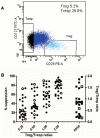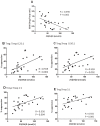Vitamin D status is positively correlated with regulatory T cell function in patients with multiple sclerosis
- PMID: 19675671
- PMCID: PMC2721656
- DOI: 10.1371/journal.pone.0006635
Vitamin D status is positively correlated with regulatory T cell function in patients with multiple sclerosis
Abstract
Background: In several autoimmune diseases, including multiple sclerosis (MS), a compromised regulatory T cell (Treg) function is believed to be critically involved in the disease process. In vitro, the biologically active metabolite of vitamin D has been shown to promote Treg development. A poor vitamin D status has been linked with MS incidence and MS disease activity. In the present study, we assess a potential in vivo correlation between vitamin D status and Treg function in relapsing remitting MS (RRMS) patients.
Methodology/principal findings: Serum levels of 25-hydroxyvitamin D (25(OH)D) were measured in 29 RRMS patients. The number of circulating Tregs was assessed by flow-cytometry, and their functionality was tested in vitro in a CFSE-based proliferation suppression assay. Additionally, the intracellular cytokine profile of T helper cells was determined directly ex-vivo by flow-cytometry. Serum levels of 25(OH)D correlated positively with the ability of Tregs to suppress T cell proliferation (R = 0.590, P = 0.002). No correlation between 25(OH)D levels and the number of Tregs was found. The IFN-gamma/IL-4 ratio (Th1/Th2-balance) was more directed towards IL-4 in patients with favourable 25(OH)D levels (R = -0.435, P = 0.023).
Conclusions/significance: These results show an association of high 25(OH)D levels with an improved Treg function, and with skewing of the Th1/Th2 balance towards Th2. These findings suggest that vitamin D is an important promoter of T cell regulation in vivo in MS patients. It is tempting to speculate that our results may not only hold for MS, but also for other autoimmune diseases. Future intervention studies will show whether modulation of vitamin D status results in modulation of the T cell response and subsequent amelioration of disease activity.
Conflict of interest statement
Figures





Similar articles
-
Regulatory T cell function correlates with serum 25-hydroxyvitamin D, but not with 1,25-dihydroxyvitamin D, parathyroid hormone and calcium levels in patients with relapsing remitting multiple sclerosis.J Steroid Biochem Mol Biol. 2010 Jul;121(1-2):243-6. doi: 10.1016/j.jsbmb.2010.03.001. Epub 2010 Mar 6. J Steroid Biochem Mol Biol. 2010. PMID: 20211254
-
Vitamin D modulates peripheral immunity in patients with Behçet's disease.Clin Exp Rheumatol. 2010 Jul-Aug;28(4 Suppl 60):S50-7. Epub 2010 Sep 24. Clin Exp Rheumatol. 2010. PMID: 20868571
-
Safety and T cell modulating effects of high dose vitamin D3 supplementation in multiple sclerosis.PLoS One. 2010 Dec 13;5(12):e15235. doi: 10.1371/journal.pone.0015235. PLoS One. 2010. PMID: 21179201 Free PMC article.
-
A low vitamin D status at diagnosis is associated with an early conversion to secondary progressive multiple sclerosis.J Steroid Biochem Mol Biol. 2016 Nov;164:254-257. doi: 10.1016/j.jsbmb.2015.11.009. Epub 2015 Nov 17. J Steroid Biochem Mol Biol. 2016. PMID: 26598277 Review.
-
Regulatory T Cells in Multiple Sclerosis Diagnostics-What Do We Know So Far?J Pers Med. 2023 Dec 25;14(1):29. doi: 10.3390/jpm14010029. J Pers Med. 2023. PMID: 38248730 Free PMC article. Review.
Cited by
-
What went wrong? The flawed concept of cerebrospinal venous insufficiency.J Cereb Blood Flow Metab. 2013 May;33(5):657-68. doi: 10.1038/jcbfm.2013.31. Epub 2013 Feb 27. J Cereb Blood Flow Metab. 2013. PMID: 23443168 Free PMC article. Review.
-
Oral and Topical Vitamin D, Sunshine, and UVB Phototherapy Safely Control Psoriasis in Patients with Normal Pretreatment Serum 25-Hydroxyvitamin D Concentrations: A Literature Review and Discussion of Health Implications.Nutrients. 2021 Apr 29;13(5):1511. doi: 10.3390/nu13051511. Nutrients. 2021. PMID: 33947070 Free PMC article. Review.
-
Effects of vitamin D3, calcipotriol and FTY720 on the expression of surface molecules and cytolytic activities of human natural killer cells and dendritic cells.Toxins (Basel). 2013 Oct 28;5(11):1932-47. doi: 10.3390/toxins5111932. Toxins (Basel). 2013. PMID: 24169587 Free PMC article.
-
Role of vitamin D in immune responses and autoimmune diseases, with emphasis on its role in multiple sclerosis.Neurosci Bull. 2010 Dec;26(6):445-54. doi: 10.1007/s12264-010-0731-8. Neurosci Bull. 2010. PMID: 21113195 Free PMC article. Review.
-
1,25-dihydroxyvitamin D3 modulates cytokine production induced by Candida albicans: impact of seasonal variation of immune responses.J Infect Dis. 2011 Jan 1;203(1):122-30. doi: 10.1093/infdis/jiq008. J Infect Dis. 2011. PMID: 21148505 Free PMC article.
References
-
- Compston A, Coles A. Multiple Sclerosis. Lancet. 2008;372:1502–1517. - PubMed
-
- Bar-Or A. The immunology of multiple sclerosis. Semin Neurol. 2008;28:29–45. - PubMed
-
- Steinman L. A brief history of T(h)17, the first major revision in the T(h)1/T(h)2 hypothesis of T cell-mediated tissue damage. Nat Med. 2007;13:139–145. - PubMed
-
- Sakaguchi S, Yamaguchi T, Nomura T, Ono M. Regulatory T cells and immune tolerance. Cell. 2008;133:775–787. - PubMed
MeSH terms
Substances
LinkOut - more resources
Full Text Sources
Medical

